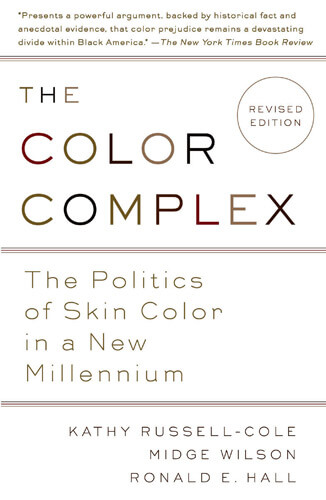“The Color Complex: The Politics of Skin Color in a New Millennium”
c.1992, 2013, Anchor
$16.00 / $19.00 Canada
288 pages
This month, you’ve decided you need a whole new look.
Your hair and wardrobe are out of date, so you’re getting a cut-and-style and a fresh wardrobe, shoes and all. You’ve got an appointment for a mani-pedi, a dermatologist, dentist, and – no more glasses! – you’re getting some of those colored contacts.
But there’s one thing you can’t alter. And in the newly updated book “The Color Complex” by Kathy Russel-Cole, Midge Wilson, and Ronald E. Hall, you’ll see how much it still matters.
The more things change, the more they remain the same…
In the last two decades, America has seen a revolution when it comes to issues of race. The generation that was born and has grown up in that time is “much more racially diverse than any other before it…” Economic powerhouses in India, China and Brazil have emerged, mixed-race relationships barely make us blink, even the government has added multiracial categories on census forms.
There’s been a lot of change, but “colorism” – a word referring to prejudices surrounding skin-color differences, particularly within the African American community – remains. What’s worse, it’s infiltrated popular culture with a subtler, seemingly-nastier effect on its victims.
Though “… skin color has maintained an intimate relationship with class” since “the earliest times,” the issue of colorism has its American roots in the early 1500s when “mulatto” offspring of White men and Black women gained power through education and social bridging between Black and White populations. Later, preference was shown for lighter-skinned individuals as “house slaves,” who largely disparaged darker-skinned field workers.
Today, several decades after discrimination based on color was made illegal, colorism still exists. Some blame it on music videos and Black songwriters. Others accuse fashion and movies. The authors also point at politics and world policy, yet they say that there are things you can do to “lessen colorism’s pernicious effects.”
Contact television networks if you notice a lack of Black journalists or actors. Let editors know that you won’t purchase their magazines until they stop Photoshopping pictures of models of color. Use the power of social media to further your cause, state your opinions, and gather support.
These days, it seems that we like to pretend we live in an enlightened world that’s on its way to being “color-blind.” We have a Black president, after all, and today’s youth are more accepting of racial differences. Some think we’ve gotten past skin color, but reading “The Color Complex” shows otherwise.
With great dismay and a surprising amount of quietly cynical humor, authors Kathy Russell-Cole, Midge Wilson, and Ronald E. Hall re-examine the divisiveness of colorism today, in contrast to what it was two decades ago. New, eye-opening research and fresh information show readers that though there are gains in some areas, colorism is far from a dead issue; in fact, with the rise of globalism, it’s actually spread.
This is a fascinating, albeit quite uncomfortable book that I recommend for audiences both Black and White. Newly updated, “The Color Complex” deserves a whole new look.





















